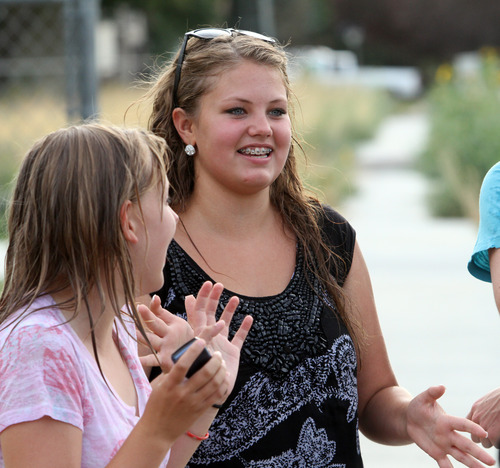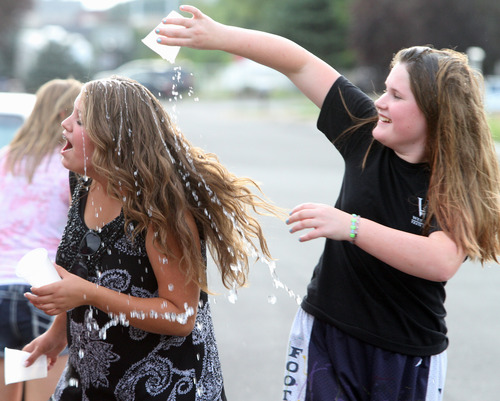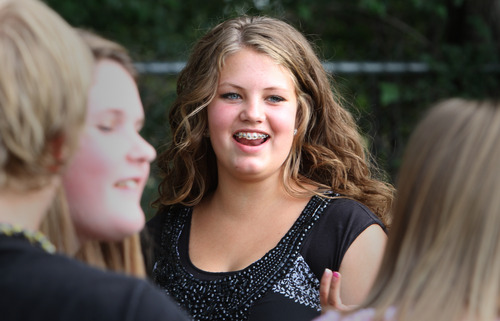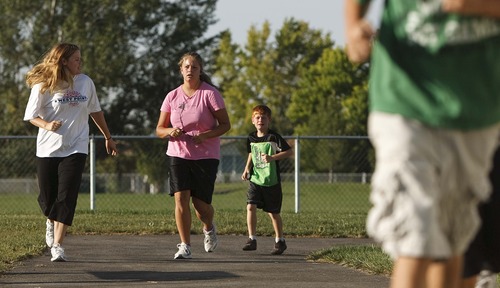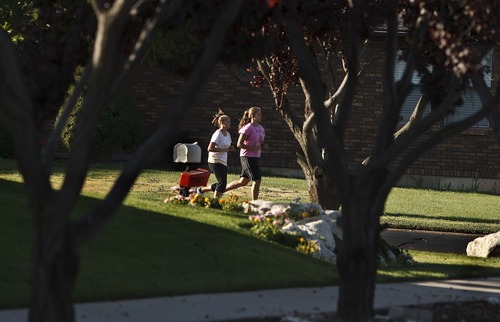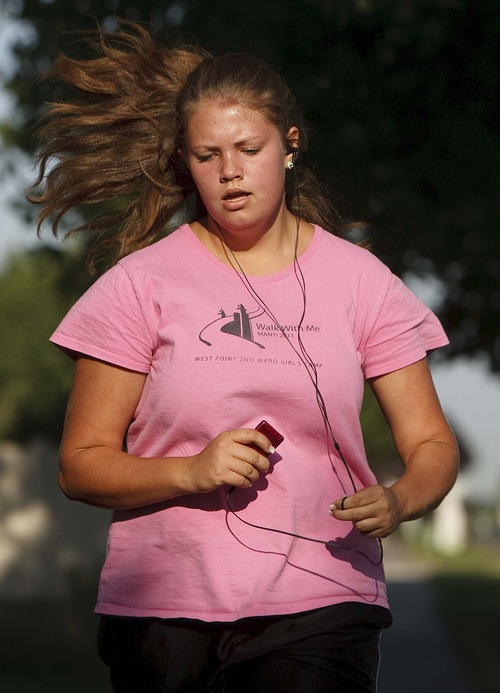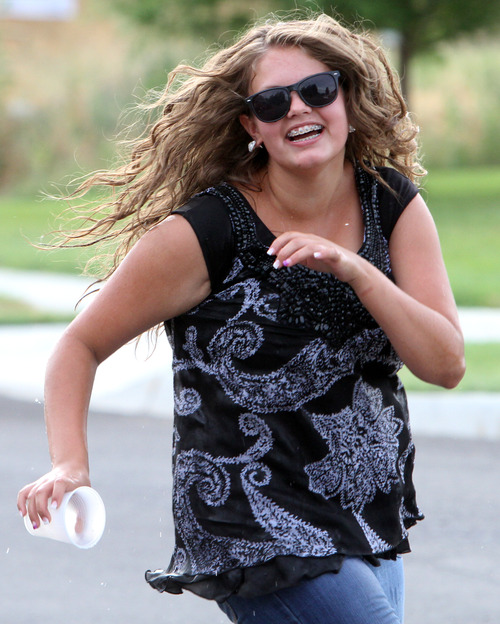This is an archived article that was published on sltrib.com in 2013, and information in the article may be outdated. It is provided only for personal research purposes and may not be reprinted.
A new Salt Lake City high school is proving the perfect laboratory for the proposition that secondary schools should start later in the morning than the typical 7:30 or 7:40 a.m. bell time.
Students at Innovations High School show up when they are ready to learn. So when do most darken the door? Right about 8:45 a.m., says an unsurprised Principal Kenneth Grover.
"We almost see a direct correlation with the research," says Grover, who launched the school last year for the Salt Lake City district, where he remains director of secondary education.
Since the early 1990s, medical research worldwide has shown that the circadian rhythms of those going through puberty — roughly ages 12 to 19 — differ from younger children and adults. In a culture where teens and adults both suffer from sleep deprivation, teenagers' biological clocks are an added complication. It's tough for teenagers to fall asleep much before 11 p.m. or wake up before 8 a.m.
Research in schools that have gone to late starts shows better attendance and grades as well as less depression among students.
Yet relatively few of the 14,000 school districts in the country have adapted by reversing the trend toward early morning starts that began in the 1970s.
According to the U.S. Department of Education's National Center for Education Statistics, the average start time for the nation's 19,270 public high schools is 8 a.m., but 40 percent start earlier than that and only 15 percent start at 8:30 a.m. or later.
"I see it, as do many of my colleagues, as a bit of a no-brainer," says Amy Wolfson, a psychology professor at College of the Holy Cross in Worcester, Mass., and a teen sleep researcher.
"When we are so concerned about education in the United States and around the world, why would we not pay attention to this?" says Wolfson. "It's just always been illogical."
Grover says the resistance is largely about convenience for adults — teachers and other staff — in the school systems. But there is also the cost.
His own district put the transportation price tag for changing to a late start at $2.1 million in the first year and $727,000 in subsequent years. The district nixed the idea after that 2000 study (schools in other states have found the opposite).
Some Utah schools start late one day a week or on occasion, but it's generally for teacher collaboration or student-teacher meetings; more sleep for students is just an added benefit.
Even the three Jordan School District schools that tried a 7:55 a.m. start time are now backing off. The bell will ring at 7:30 a.m. at Herriman High and 7:40 a.m. at Copper Hills High and West Jordan High when school begins later this month.
"We as adults stand in the way of students succeeding," says Grover. "It's clear we're going against proven research. We know, but act opposite of our knowledge."
—
School-life balance • Flexibility and control are precisely the reasons Ammi and Benjamin Orton, of West Point, enroll their five children in online charter schools.
Ammi Orton awakens her children, ages 6 to 15, between 7:30 and 8 a.m. each day, even in summer, and the first thing on the agenda is a 2-mile walk or run together.
So later this month, while Julianne Orton, 15, is rolling out of bed for a run with her siblings, her peers at nearby high schools will have been up for hours.
"When I tell my friends when I get up, they are like, 'Are you kidding me? That's when I have to be in class,'" says Orton, who will be a sophomore at Mountain Heights Academy this fall.
The online charter school, formerly Open High School of Utah, changed its name to reflect the addition of 7th and 8th grades this year. Orton's sister, Katie, 12, will be in Mountain Heights' 7th grade.
Ammi Orton says it would not be possible to exercise as a family if her children had buses to catch and school bells ringing at different hours.
"I like the flexibility," says Ammi Orton, who home-schooled her older children before enrolling them in online charter schools. "I can structure my time how I want it. It can be my program and not necessarily [the schools']."
Mountain Heights Director DeLaina Tonks says most of her students see the chance to sleep in as a "huge benefit."
But while they may arise later than their peers in traditional schools, "It's not like they are slackers and sleeping in every day till noon."
In fact, the school took an informal poll for the yearbook last year and learned that 39 percent of students arise at 9 a.m. each day.
Twenty-two percent said they get up at 6:30 a.m. and 13 percent get up at noon.
Online schools, she says, provide "flexibility to fit school into life," instead of the reverse. "It puts the student in the driver's seat."
—
Late or lazy? • Kari Oakes, research director for Start School Later, a nonprofit composed largely of medical professionals and parents, says the culture is partly to blame for schools' slow adoption of late start schedules.
"A lot of it is our late 20th, early 21st century mentality that we've got to suck it up and work harder, no matter what.
"There's a perception that teenagers are lazy and don't want to work, and sleeping in late in America is equated with being lazy," she says.
Her organization is trying to educate the public about the biological facts. "This isn't made up. It's real," says Oakes, a physician assistant who watched her daughter grow ragged and sick from getting up at 5:30 a.m. to catch the bus in Maryland.
Start School Later had a national petition drive to encourage schools to start after 8 a.m. and is now developing a project, Stand up for Teen Sleep, that would share the science with school nurses and social workers who could then advocate for more sleep for teenagers, she says.
Going to late start, says Oakes, "is one of the easiest and cheapest ways to make a change that can really create a lot of benefit."
Even economists make that point. A 2011 study by the Brookings Institution identifies a late start as one of three cost-effective educational reforms that could make a difference in students' lives.
In fact, they concluded students could earn $17,500 more over their lifetimes because late-start schools result in improved test scores, and higher test scores translate into higher incomes.
Kyla Wahlstrom, director at the University of Minnesota's Center for Applied Research and Education Improvement, says the late-start campaign may become moot as more schools move online or toward hybrids like Innovations High School.
Students there attend a brick-and-mortar school six hours a day, but there are no bells or class periods and students do most of their classwork online or at the adjacent community college.
Still, it vexes Wahlstrom, who was a school teacher and administrator for 20 years before becoming an academic, that states have not, en masse, gone to late starts for middle and high schools.
"It's a politically hot topic," she says. "I know of three superintendents in the U.S. who lost their jobs over this. They championed it and their boards disagreed."
School districts often cite transportation costs if they can't stagger start times over several hours and balk at pushing extracurricular activities even later into the day.
—
"The new normal" • Wahlstrom is one of the researchers who documented the improved school attendance, higher grades and fewer depressive feelings among students in Minnesota schools that changed to late-starts in the mid-1990s.
When complications arose, schools and families got creative, she says.
For instance, in Minneapolis, parents formed block clubs so one parent would stay at bus stops with elementary schoolchildren whose start times were switched earlier so older students could go later. The school district more recently solved transportation troubles by giving high school students public transit passes, she says.
Schools are vital to the rhythm of a community, but communities adjust to change, Wahlstrom says. "The new schedule settles in and becomes the new normal."
A late start did not become the new normal at Utah's Herriman High, however.
Principal Jim Birch says the school will go back to an earlier start — 7:30 a.m. — this fall after two years of starting just before 8 a.m.
The school didn't see the results it wanted — struggling students coming early to meet with teachers.
While some parents and students loved the later start because of the chance for more Z's, Birch says a survey last year revealed students were not getting any more sleep than before.
"A lot of them said, 'We go to bed later because we can get up later.' "
Others in Utah are also dubious that ringing the bells later would make a big difference for students.
Bryce Williams, a University of Utah physician who treats children with sleep problems associated with physical abnormalities, says there are many factors affecting teen sleep today, including electronic gadgets, caffeinated drinks, obesity and more-rigorous schedules.
While educating students about sleep hygiene is smart, he says, "I don't know if going to a later schedule is the answer."
Economists at Brigham Young University also wonder if the campaign for later starts isn't based on an unexamined understanding of how much sleep is optimal for teens.
"It's not clear that schools ought to be investing a huge amount in backing up their school times because kids will adjust," says Mark Showalter, who with Eric Eide published a 2012 study on teens and sleep in the Eastern Economic Journal.
Their analysis of data collected in a national survey found that the students who did best on math and English tests got 7 to 7 ½ hours of sleep nightly, far less than the standard accepted by most sleep researchers, which is 8 to 9 ½ hours of sleep.
"We're not saying test scores trump overall well-being of the child," Eide says. But the data did suggest that "there is a wide range of sleep consistent with doing well," Showalter says.
But Oakes, of Start School Later, and sleep researchers say there is overwhelming data that teens need more sleep than they are getting — even if that can't always be measured by test scores.
"Who among us thinks that measuring human beings by test scores is the best way to measure them?" Oakes asks. "First comes health, then comes everything else."
Twitter: @KristenMoulton —
It's about biology
Just as a baby's first step is a developmental benchmark, so is the onset of puberty and the adolescent brain's secretion of melatonin, which makes a teenager sleepy from about 11 p.m. to 8 a.m.
For nearly 25 years, medical research into adolescent sleep has suggested that middle and high schools start later to accommodate students' unique biology.
Lack of sleep has been associated with depression, suicidal thoughts and car wrecks among teens, and academic performance is tied to duration of sleep and school start times.
Follow these links to learn about some of the best studies:
Sleep For Science Sleep Research Lab at Brown University > bit.ly/1bcWjLZ
Start School Later > bit.ly/19bkZal
Recent top study on academic performance > bit.ly/nOxXvA



